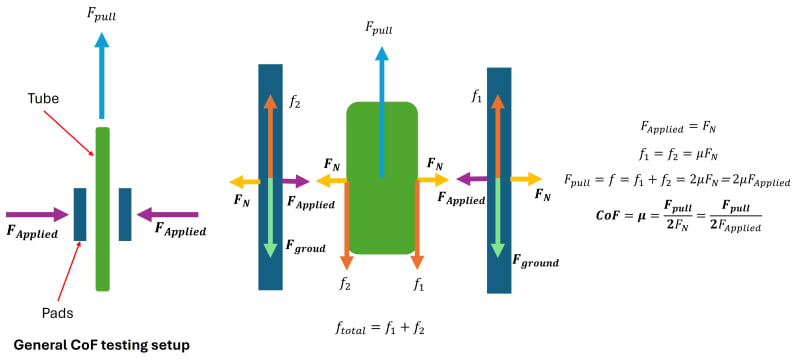Joccob
Mechanical
- Apr 22, 2021
- 7
Hi,
I worked in medical catheter industry and recently had some problems with simple CoF calculation. Because we normally work with catheters and tubes, instead of using standard ASTM D1894 testing method, we usually use so called "Pinch Test" to determine the CoF of the catheter surface. I simplified it into a diagram and attached below. Or you can search "Harland Friction Testing Machine" to get an idea of how it works.

It looks like a very simple problem, you clamp the catheter with force "N" and measure the pulling force. Because you need two pads to clamp it, there are then two friction forces. so the final calculation, as shown in the diagram, should be CoF=F-pull/2*N. But then one of my colleagues told me that there should be no denominator of 2 and CoF simply equals to F-pull/N. I also reached out to some friction testing machine supplier, and they also said that it should be F-pull/N (although they didn't explain in details on what is N). Now I'm totally confused cause I couldn't find out wwhy my calculation is wrong.
I'd really appreciate it if some one experienced with friction calculation to help me out.
I worked in medical catheter industry and recently had some problems with simple CoF calculation. Because we normally work with catheters and tubes, instead of using standard ASTM D1894 testing method, we usually use so called "Pinch Test" to determine the CoF of the catheter surface. I simplified it into a diagram and attached below. Or you can search "Harland Friction Testing Machine" to get an idea of how it works.

It looks like a very simple problem, you clamp the catheter with force "N" and measure the pulling force. Because you need two pads to clamp it, there are then two friction forces. so the final calculation, as shown in the diagram, should be CoF=F-pull/2*N. But then one of my colleagues told me that there should be no denominator of 2 and CoF simply equals to F-pull/N. I also reached out to some friction testing machine supplier, and they also said that it should be F-pull/N (although they didn't explain in details on what is N). Now I'm totally confused cause I couldn't find out wwhy my calculation is wrong.
I'd really appreciate it if some one experienced with friction calculation to help me out.
